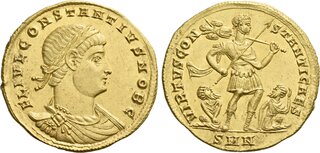| Numismatica Ars Classica > Auction 146 | Auction date: 8 May 2024 |
| Lot number: 2408 Price realized: This lot is for sale in an upcoming auction - Bid on this lot  | Show similar lots on CoinArchives Find similar lots in upcoming auctions on |
| Lot description: Constantius II caesar, 324 – 337. Medallion of 2 solidi, Nicomedia 325, AV 27 mm, 8.93 g. FL IVL CONSTANTIVS NOB CAES Laureate, draped and cuirassed bust r. Rev. VIRTVS CON – STANTI CAES The Prince, in military attire, advancing r., holding trophy across l. shoulder and spear in r. hand; on ground, at either side, captive sitting. In exergue, SMN. C –, cf. 321 (medallion of 1 1/5). RIC –, cf. 135 (medallion of 1 1/5). Alföldi –, cf. 688 (medallion of 1 1/5). Depeyrot –, cf. p. 155 (unlisted medallion of 2). Apparently unrecorded as two solidi medallion. A very attractive portrait and an interesting reverse composition. Two unobtrusive edge nicks and minor marks, otherwise virtually as struck and almost Fdc Constantius II was the third son of Constantine the Great and born at Sirmium in 317. Desirous of maintaining a long list of viable heirs from his own bloodline, Constantine fast tracked the infant Constantius II through the late Roman cursus honorum and granted him the title of Caesar at the age of seven on 8 November 324. Although previously the title of Caesar had served to indicate a secondary emperor to assist the senior emperor, or Augustus, under Constantine it increasingly lost much of its administrative meaning and came to be a title used to distinguish imperial heirs. At seven years old, Constantius II was not likely to have been of great use in dealing with the many serious internal and external problems that beset the Roman Empire. This impressive solidus multiple was struck shortly after the elevation of the young Constantius II, probably for distribution as a donative to the army during the Roman New Year's festival in January 325. There is no better way for a ruler to introduce a child heir to the army than through the liberal use of gold-the stuff upon which all late Roman military loyalty was built. The types of this medallion really try to build up Constantius II for the military audience. Despite his great youth at the time of production, on the obverse he is represented wearing the laurel wreath appropriate to his station as Caesar-senior rulers of the late third and early fourth centuries regularly wore a jeweled diadem-and the cuirass with triumphal cloak of a successful commander. On the reverse however, the engraver has gone far over the top in his depiction of Constantius II as a great warrior. The seven-year-old is shown towering over his defeated enemies, although it is not clear precisely what conflict he may have fought in. Licinius, the great rival of his father, had been defeated at the Battle of Chrysopolis on 18 September 324 and executed in 325, but the bearded barbarian captives beneath the feet of Constantius II suggest some other (invented?) occasion on which he supposedly displayed such precocious manliness. Constantine the Great won signal victories against the Sarmatians and Visigoths in 322 and 323, but this would mean that Constantius II showed the impressive bravery represented here at the side of his father when he was only five or six. Estimate: 40000 CHF |  |



